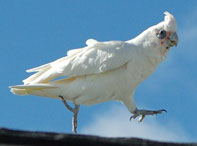My formal introduction to positive reinforcement was not exactly early on in my bird-owning career, but the concept was so effectively delivered that in one fell swoop, my quest for knowledge took a sharp turn in a new direction, leaving behind all of the antiquated parrot behavior advice that never quite made sense to me: demanding a bird step up every time it is commanded, only allowing the bird to come out of his cage on your hand and not on his own time, and the use of the drama reward and the evil eye. In my college years, I worked for a parrot breeder who sent me to a lecture with Steve Martin, owner of Natural Encounters, Inc., which introduced me to the idea of operant conditioning and how animals learn. Suddenly, I could not learn about behavior fast enough, it seemed.
how animals learn. Suddenly, I could not learn about behavior fast enough, it seemed.
Fast forward a decade: we now have the likes of Steve, Barbara Heidenreich, Sid Price, and Dr. Susan Friedman, among others, helping to build this wave of knowledge, broadening the scope of operant conditioning and behavior science to everyday companion animal owners and zookeepers. That said, there is a huge difference in the positive reinforcement techniques rooted in behavior science from the aforementioned positive reinforcement gurus than the breed of R+ they sell at your nearest big box pet store. To make matters more challenging, if we were to search YouTube for positive reinforcement training videos, for instance, we would see an incredibly wide variety of philosophies, in addition to atrocious misuses of behavior science principles that further lead to the confusion about what positive reinforcement actually is.
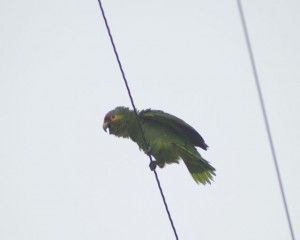 Training with positive reinforcement should not just be about rewarding our animal companions as we teach them “manners” and using force, intimidation, and punishing methods to get rid of unwanted behaviors. If we think of behavior change as a wheel, with positive reinforcement as the hub, there are many, many spokes that offer supporting roles to make R+ more effective….
Training with positive reinforcement should not just be about rewarding our animal companions as we teach them “manners” and using force, intimidation, and punishing methods to get rid of unwanted behaviors. If we think of behavior change as a wheel, with positive reinforcement as the hub, there are many, many spokes that offer supporting roles to make R+ more effective….
Briefly, a few spokes include:
* Avoiding the use of aversives (something your animal wants to get away from), force, or coercion.
* Working within the animal’s comfort level and stopping at the first sign of discomfort
* Creating a stimulating environment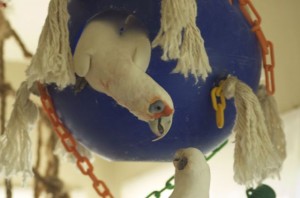
* Empowering the animal to make choices about what it is and is not comfortable with
* Assessing body language with a keen eye to prevent signs of discomfort from escalating to extreme, unwanted behaviors
* Positively reinforcing desirable behaviors to achieve outcomes of equal or greater value than the outcomes undesirable behavior produces…. Dr. Susan Friedman (www.behaviorworks.org) refers to this as replacing behaviors rather than eliminating behaviors. A parrot that screams for you attention can be taught to talk or jingle a bell for the same effect. A dog that jumps up to receive pets from visitors can be taught to sit for petting instead.
This is just a small sampling of tools that can be applied to make positive reinforcement a life skill, rather than just a program to train your bird to step on your hand. Because there are so many spokes in our wheel and the amount of choice can stress and confuse even a seasoned trainer, I try to start with three basic components that should be :
1.) Using observable data to analyze behavior. This means describing what a bird does rather than what we think he is. For instance, instead of saying territorial, we say that the bird lunges, pins his eyes, and bites our hands when he is on top of his cage. The reason that this is so important is because it shifts our thinking in terms of immutable qualities 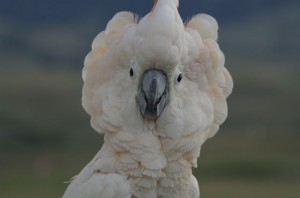 that our birds possess to assessing the environment’s role in our companions’ problem behaviors. Using this idea, we identify factors we have the capability to change that influence the target behavior.
that our birds possess to assessing the environment’s role in our companions’ problem behaviors. Using this idea, we identify factors we have the capability to change that influence the target behavior.
2.) Thoughtful arrangement of the environment. Creating a supportive environment for healthy behavior means customizing your companion’s environment to make it easier for the bird to behave in desirable ways. A bird that has access to its favorite types of enrichment will have less time for screaming, inappropriate chewing, and feather destructive behavior. If the bird displays aggressive behavior toward one family member, perhaps that person can be the only deliverer of goodies to help change their reinforcing value. Simple changes in the environment can make a big difference in your bird’s behavioral repertoire, and focusing on the antecedents of behavior over the consequences allows us to be so much more effective at reducing problem behavior.
3.) Two-way communication. This concept is what stood out to me in that first lecture I heard from Steve Martin. A hugely important component of any relationship is the ability for both parties to receive and transmit information. This is no different with you and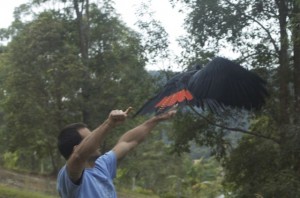 your bird. Just as you cue your bird that you want him to step up by putting out your hand, a bird has cues of his own that indicate his desires. Three important hallmarks of two-way communication are honesty, feedback, and empowerment. Honesty means that the animal is always aware of what it is that we are asking. We don’t distract an animal so that we can “steal” a pet, we systematically train that animal to exhibit calm behavior while we pet it. Utilizing feedback means we allow the animal’s body language to be a dialogue about his comfort level and readiness. There should be a fluid exchange of information between the animal and human, and ignoring this undermines this relationship tremendously. And finally, empowerment means that the animal is not mandated or forced to participate in the relationship, but it has the skills and motivation to do so.
your bird. Just as you cue your bird that you want him to step up by putting out your hand, a bird has cues of his own that indicate his desires. Three important hallmarks of two-way communication are honesty, feedback, and empowerment. Honesty means that the animal is always aware of what it is that we are asking. We don’t distract an animal so that we can “steal” a pet, we systematically train that animal to exhibit calm behavior while we pet it. Utilizing feedback means we allow the animal’s body language to be a dialogue about his comfort level and readiness. There should be a fluid exchange of information between the animal and human, and ignoring this undermines this relationship tremendously. And finally, empowerment means that the animal is not mandated or forced to participate in the relationship, but it has the skills and motivation to do so.
For more great learning about empowerment and positive reinforcement, I highly recommend this interesting manifesto of Emily Larlham, a San Diego area dog trainer: http://www.dogmantics.com/Dogmantics/Progressive_Reinforcement_Manifesto.html.
Jim McKendry of Parrot Behavior and Enrichment Consultations: “So…How far have we come?” http://parrotconsultations.blogspot.com/
The truth is, you don’t have to have a graduate degree in behavior science just to succeed in Parrot Relationships 101. But behavior is undoubtedly complex, and what I have found most important is the need to critically observe the environmental conditions that lead to problem behaviors. The comprehensive application of program based on positive reinforcement is not about quick fixes but changing the way we view behavior on the whole. Such a process doesn’t happen overnight, but the successes you achieve will certainly reinforce the desire to learn!
hh

